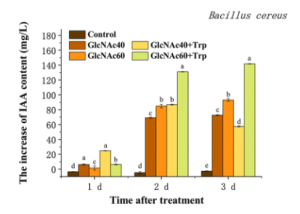A group from State Key Laboratory of Food Nutrition and Safety, College of Food Science and Engineering, Tianjin University of Science and Technology, Tianjin, China, etc. has demonstrated that N-GlcNAc has a plant growth promoting effect.
https://pubmed.ncbi.nlm.nih.gov/35665438/
Chitin is the second most abundant polysaccharide in living organisms, following cellulose. Chitin and chitosan are biodegradable and nontoxic, drawing increasing attention due to their ability to improve soil and substrate quality, plant growth, and plant resilience and to contribute extensively to the development of enhanced and sustainable crop production. The addition of chitin and its derivatives can improve the fresh yield weight of many crops. However, knowledge of their specific functions in plant growth promotion, cultivation, and agro-environmental sustainability remains limited, restricting their further contribution to yield increase, the predictable activation of plant defenses, the extension of harvest storage life, and the improvement of slow release of optimized nutrients in fertilizers for agricultural products and their microbiomes.
N-Acetyl-D-glucosamine (N-GlcNAc), the most abundant carbon-nitrogen bio compound on Earth, is a derivatized glucose monomer found in polymers of chitin, chitosan, and peptidoglycan, which are major constituents of arthropod exoskeletons, filamentous fungi, and bacterial cell walls.
Using Tomato as a model plant, a hypothesis that N-GlcNAc promotes plant growth was examined. As expected, N-GlcNAc-treated plants produced greater plant height, greater whole fresh weight, and greater stem weight in natural soil. The increase in plant height of N-GlcNAc-exposed plants was 1.29-fold comparing with the control. The whole fresh weight of N-GlcNAc-exposed plants was 1.33-fold that of plants comparing with the control.
The rhizosphere soil samples exposed to N-GlcNAc contained 142 unique OTUs that contained relatively abundant Proteobacteria, Actinobacteria, and Planctomycetes. The relative abundance of Proteobacteria and Actinobacteria in the rhizosphere soil samples of N-GlcNAc-exposed plants was increased by 3.89% and 45.82% comparing with the control, respectively.
Interestingly, auxin indole-3-acetic acid (IAA) produced by B. cereus increased with N-GlcNAc treatment and reached 92.9 mg/L when cocultured with 60 mmol/L N-GlcNAc in LB medium. This ability of N-GlcNAc to activate IAA production was dependent on supplying the exogenous substrate tryptophan to the strains of P. mirabilis and P. putida. The addition of tryptophan also promoted the accumulation of IAA in strains of B. cereus and S. thermocarboxydus.
Thus, this study provides a new direction for understanding and utilizing the benefits and stability of PGPRs in the field and reveals a key microbial signaling molecule, N-GlcNAc, which shapes the microbial community structure and induces changes in metabolism of the rhizosphere microbiome, thereby simultaneously enhancing plant growth.

